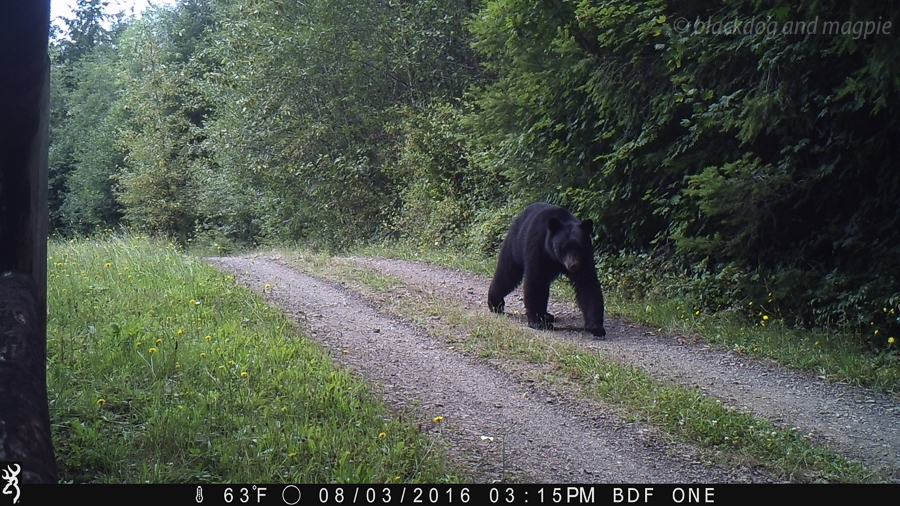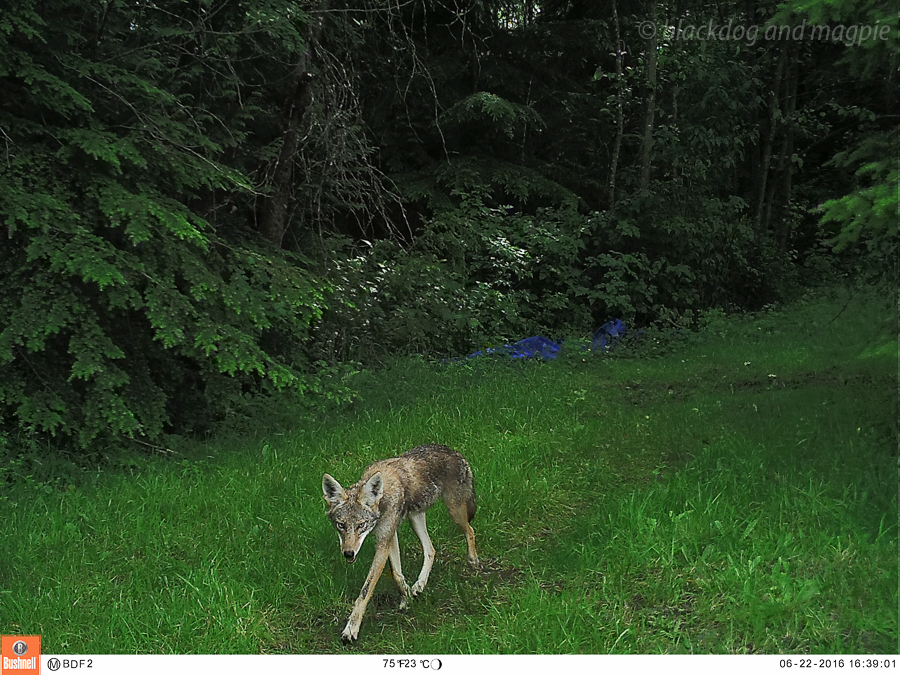There are things in the woods.
Paying attention is one of the fundamental tasks of being human being. Paying attention to what’s around us is a survival skill. Paying attention keeps us from being eaten by lions, helps us to find nuts and berries, and keeps track of our mates. But it is more, it is also one of the ways in which we indicate what things are important to us. It signals what we value and what we feel responsible for, even as paying attention changes our relationship with those things.
Lately I’ve been thinking about a particularly local sort of paying attention. The attention that I focus on the bit of the Earth that I feel particularly responsible for, the small ground of 20 acres of forest and pasture, the house and the business that make up Black Dog Farm. On any day there are sheep to feed and water, eggs to collect from under broody hens, dogs to be exercised and trained. Meals must be prepared, jobs attended to, and the buildings maintained. All of these things and more must be carefully and mindfully attended to lest a sick sheep or a client’s deadline escape our notice.
We share the farm yards with a number of wild animals in addition to the domesticated ones that we care for. In spring and summer there are swallows nesting in the barn and the equipment shed. Their daytime aerobatics are replaced by the swooping of bats at twilight. In the winter there are birds at the edges of the woods and at feeders and baths, as well as the squirrels and chipmunks that try to rob them. Year round the bunnies run across the driveway in front of the cars and into hurdle themselves into the underbrush at the edges of the woods. All of these come to our attention as we go about our daily business.
The forest that makes up the majority of our place requires and receives far less daily attention. Sometimes there are downed trees in winter and the trails need to be cut and cleared in the spring, but on the whole the woods and its denizens get along, as they did for in the decades before they became our woods, without our attention.
For many years, five days of the week I put on boots and heavy socks and running tights, took my dog, and went out to pound through an hour of trail running. I didn’t look up. I didn’t look ahead. I just watched where I was putting my feet and concentrated on an audio book. It was a lot like being on a tread mill except that there was weather and the dog got some exercise too. I hated it. I thought little about the place I was running in and what I might or might not be sharing the woods with.
These days the dog and I take a different kind of walk. Sometimes my husband goes along. We amble more than stride. We look around a lot, stopping to peer at a flower or to show one another a new sleeping spot for the deer. The dog crashes through the underbrush, smells all the smells, marks his territory, and waits dubiously for his monkeys to catch up. We’re all paying attention. Yet, there are a lot of things that we don’t see when we’re walking — fast or slow. The deer make themselves scarce. The little animals sit nervously in their lairs. The birds quiet down when we are underneath their nests. We know that there are coyotes, cougars, bobcats, and bears in the woods but we rarely have hard evidence to prove it. We’ve heard the coyote songs and at one point lost a lot of chickens to them. A cougar made its presence felt in the ass end of one of our sheep several years ago. This summer we caught a bear that came around to eat up our bird feeders. But we aren’t aware of their presence in the way that we are aware of the smaller animals that we see and hear every day.
About a year ago we put game cameras on our land to see what’s moving about when we’re not there. The thing about the cameras, with their unmoving plastic indifference, is that they are patient. They sit and wait. They don’t shift around. They don’t fall sleep. They don’t mumble or stink of humans. They just sit and take pictures.
On one hand it seems like a loss that I can’t see everything in the woods while I am out walking. That I don’t have the time or patience to sit still in one spot for the hours necessary to see the deer wander by or the rabbit poke it’s nose out of its burrow. On the other hand, some animals and their behaviors would simply not be visible without the cameras. Animals that actively avoid human contact or the stink of big male dog or electric fences. Animals that only pass by at night — I don’t have IR vision, but the cameras do. So much would be unknown to me without the cameras.
Our cameras see a lot. At first it was mostly the deer wandering around at dawn and dusk looking for a last bit of browse or a place to bed down for the night. Ollie, the dog who lives next door, appears regularly as do a few of the neighbors who walk in our woods. Admittedly, I feel a little weird about that — taking pictures of the neighbors. Sadly, our current cameras miss anything that weighs less than 25 or 30 pounds or that flies. Those we have to actually catch by eye. We do see the little mammals crossing the driveways or scurrying in the garden area and the great horned owl will swoop across the forest path if you happen to disturb him during his morning snooze.
We regularly move the cameras from place to place looking for more information about what happens in different parts of the woods. For the last couple of months there has been one is on the lower pasture road, next to a path that leads from our neighbor’s property onto ours in a spot where we have heard the coyotes calling. I hope to learn whether they are denning nearby and perhaps to catch a look at this year’s pups. Something that I’ve never seen before. Something I would be unlikely to see without the cameras.
Before the cameras we knew the predators are out there and we would see hints of them occasionally but we didn’t think about them much. But now — we have photographic evidence of their presence. The sense that these are their woods much more than mine is increasing. Given the time stamps on these photographs I now must face up to the fact that those animals are out in my woods not only at the times when I’m not there to see them but at hours of the day when I could quite easily be out there. A coyote pair in the middle of the pasture road at 10:00 in the morning is a pair of animals that I might startle. A bear wandering down the driveway with all the boldness of a neighborhood dog at 4:00 in the afternoon is bear that I could easily meet while taking a short break from the keyboard toward the end of a long day. A cougar (the collared female — number F17, a know livestock killer) only 100 yards from my sheep is not some predator crossing the far end of the woods in the dead of the night, it’s a cat close enough to my sheep to cause them alarm. My own atavistic fear of the things that creep about in the woods grows with each picture.
In the end I have come to terms with the cameras. They are alien presences in the woods, but so are we. The things that they show me are there — facts on the ground — whether or not I like them. And now those facts belong to me. I care about knowing them because I care about my woods. Besides, the bear has the most amazing expression on his face as he wanders down the driveway on his way to his important bear appointment.
Here’s a small collection of the things that we’ve seen. Many more pictures can be found at the farm website.













